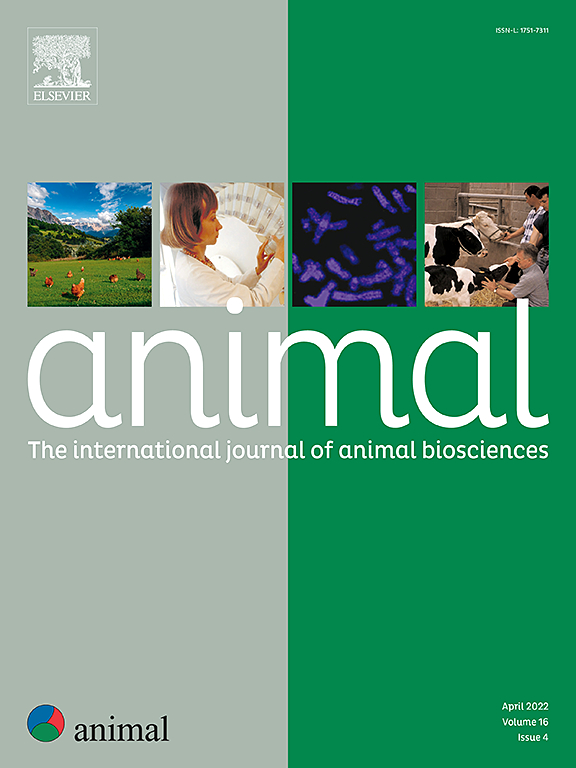Integrating eQTL and genome-wide association studies to uncover additive and dominant regulatory circuits in pig uterine capacity
IF 4.2
2区 农林科学
Q1 AGRICULTURE, DAIRY & ANIMAL SCIENCE
引用次数: 0
Abstract
Uterine capacity is critical to the economic value of pigs. Exploring the genetic mechanisms that underlie uterine capacity can provide vital insights for pig breeding programmes. Here, we used a mixed model including additive and dominance effects to conduct genome-wide association analysis followed by cross-population meta-analyses for uterine capacity in 8 782 pigs from three pig breeds across nine populations. We identified 192 lead single−nucleotide polymorphisms (SNPs) with additive-specific effects, 236 lead SNPs with dominant-specific effects, and 27 lead SNPs with additive-dominant shared effects. The effects of additive-specific and dominant-specific lead SNPs were shared across breeds to a certain degree. By integrating expression quantitative trait loci, we identified 40 potential dominant-effect and 10 potential additive-effect regulatory circuits, in which a genetic variant affects uterine capacity by modulating the expression of specific gene in specific tissue. For example, rs343882381 affects uterine capacity by regulating the expression of SLC38A10 in the uterus via a dominant effect (PSMR = 7.34 × 10−5, COLOC.PP4 > 0.5), rs337112076 affects uterine capacity by regulating the expression of TNNT1 in the brain via an additive effect (PSMR = 2.36 × 10−35, COLOC.PP4 > 0.5). Our results not only fill the knowledge gap regarding dominant genetic regulation mechanisms of uterine capacity but also provide a key theoretical foundation for the subsequent functional validation and breeding applications.
整合eQTL和全基因组关联研究,揭示猪子宫容量的加性和显性调控回路
子宫容量对猪的经济价值至关重要。探索子宫容量的遗传机制可以为猪的育种计划提供重要的见解。在这里,我们使用了一个混合模型,包括加性效应和显性效应,进行全基因组关联分析,然后对来自9个群体的3个猪品种的8 782头猪的子宫容量进行跨群体荟萃分析。我们鉴定出192个具有加性特异性效应的先导单核苷酸多态性(snp), 236个具有显性特异性效应的先导snp,以及27个具有加性显性共享效应的先导snp。加性特异性和显性特异性的铅snp效应在不同品种间有一定程度的共性。通过整合表达数量性状位点,我们确定了40个潜在的显性效应和10个潜在的加性效应调控回路,其中遗传变异通过调节特定组织中特定基因的表达来影响子宫容量。例如,rs343882381通过显性效应(PSMR = 7.34 × 10−5,COLOC)调节子宫SLC38A10的表达,从而影响子宫容量。PP4祝辞0.5), rs337112076通过加性效应调节脑TNNT1的表达影响子宫容量(PSMR = 2.36 × 10−35,COLOC)。PP4祝辞0.5)。我们的研究结果不仅填补了关于子宫容量显性遗传调控机制的知识空白,而且为后续的功能验证和育种应用提供了关键的理论基础。
本文章由计算机程序翻译,如有差异,请以英文原文为准。
求助全文
约1分钟内获得全文
求助全文
来源期刊

Animal
农林科学-奶制品与动物科学
CiteScore
7.50
自引率
2.80%
发文量
246
审稿时长
3 months
期刊介绍:
Editorial board
animal attracts the best research in animal biology and animal systems from across the spectrum of the agricultural, biomedical, and environmental sciences. It is the central element in an exciting collaboration between the British Society of Animal Science (BSAS), Institut National de la Recherche Agronomique (INRA) and the European Federation of Animal Science (EAAP) and represents a merging of three scientific journals: Animal Science; Animal Research; Reproduction, Nutrition, Development. animal publishes original cutting-edge research, ''hot'' topics and horizon-scanning reviews on animal-related aspects of the life sciences at the molecular, cellular, organ, whole animal and production system levels. The main subject areas include: breeding and genetics; nutrition; physiology and functional biology of systems; behaviour, health and welfare; farming systems, environmental impact and climate change; product quality, human health and well-being. Animal models and papers dealing with the integration of research between these topics and their impact on the environment and people are particularly welcome.
 求助内容:
求助内容: 应助结果提醒方式:
应助结果提醒方式:


